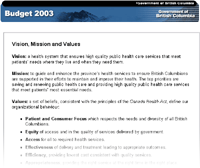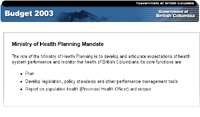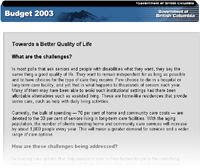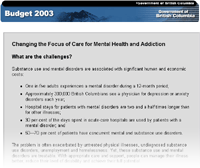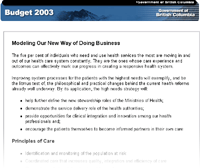 |
|
Strategic ContextSince 2001, major strategic shifts in health services have been undertaken to meet the government's New Era goals to provide high quality, patient-centred care, improve the health and wellness of British Columbians and create an affordable, sustainable health services system. The health services system in BC was designed to meet an earlier era marked by services delivered by hospitals and doctors to meet sudden acute care needs. Over the years, however, an aging population and increase in chronic diseases have put new demands on our system. We are now focused on creating a flexible, adaptable health care system that does not remain static in time but has the capacity to meet the emerging needs of our population as it grows and changes.
Environmental ScanNumerous challenges continue to face the creation of a patient-centred, coordinated and well-managed system that best meets the evolving and diverse health services needs of British Columbians. Fiscal Challenges
Demographic Trends
Key Cost Drivers
Challenges and Risks
Oportunities to Meet the ChallengesThe Ministries of Health have internal expertise in planning, monitoring and evaluation and are building stronger relationships with their health system partners. Through the recent redefinition of their core businesses, the Ministries of Health have also more clearly defined their roles and responsibilities, and those of our partners. The ministries will capitalize on these opportunities to help create a system capable of meeting our many challenges, by:
Building the System We WantNumerous task forces, Royal Commissions and researchers in both Canada and other western nations have noted common elements that distinguish a responsive patient-centred health care system. The 2003 First Ministers' Health Accord also listed the factors which make a patient-centred health system. In BC, such a system would ensure that all British Columbians:
Knowing Our PatientsTo create a patient-centred, accessible health care system that meets these criteria, we first need to better understand the specific needs of the people we are trying to serve. All British Columbians need effective public health services, which provide health promotion and protection, effective immunizations, and infectious disease prevention and control; and monitor and regulate water, food and environmental safety. Beyond good public health, the health needs of BC's population can be divided roughly into three distinctive groups: 1. A majority (about 80%) with infrequent, episodic health needs. Most British Columbians enjoy generally good health status. They want reassurance the health system will be there when they need it. When they do access care, it is usually to deal with an acute illness or injury, such as broken bone, or other time-limited events. What patient-centered, accessible care looks like for them:
2. A minority (about 15%) with early or stable chronic diseases. These British Columbians have early chronic health problems, such as asthma, diabetes, cardiovascular disease or mental illness, that put them at high risk of future complications and worsening health. What patient-centered, accessible care looks like for them:
3. A small minority (about 5%) with multiple or severe chronic illnesses and extremely high care needs. This small percentage of the population (about 200,000 people) need and use care the most. Research finds that they account for about one-third of all physician visits and all hospital admissions and about two-thirds of all hospital days. They can include frail elderly people with multiple health problems; people with terminal illnesses or incurable conditions, such as congestive heart failure; or people with severe mental illnesses complicated by physical disease or addictions. Some of these individuals may have a sudden health crisis, such as an accident or diagnosis of cancer, which entails intense treatment and contact with health services for perhaps a year or so, but then return to generally good health in subsequent years. What patient-centered, accessible care looks like for them:
Working with Partners to Meet Patients' NeedsHealth care in BC is delivered in partnership. While the Ministries of Health directly deliver a select number of services to the public, such as the BC Ambulance Service, health authorities and other system partners such as doctors and pharmacists are responsible for delivering the vast majority of health programs and services to British Columbians. The Ministries of Health will assist our partners in meeting system objectives and priority strategies by providing clear direction and support. Setting policies, creating legislation, providing data and research backing, providing expertise and best practice information, aligning performance with incentives, and linking partners to create best practice networks are some examples of the direction and support that the ministries can provide. Across the provincial health care system, there areexamples of innovation and excellence in service delivery. Forerunners in developing improved care patterns in areas such as palliative care and all-inclusive care for the frail elderly are setting the direction for the health system as a whole to move forward. In their stewardship role, the Ministries of Health will work closely with service delivery partners (e.g., health authorities (HAs), doctors, pharmacists) to facilitate the sharing of best practices knowledge and help support them in delivering leading edge services to the people of BC. Further, planning partnerships with health care deliverers will help ensure that government's strategic priorities are both defensible and guide actual service delivery. The relationships the ministries have with health authorities, provider associations, and counterparts from federal, provincial, and local governments will be further enhanced to meet future challenges by:
What Are We Doing to Create the System We Want?The ministries have identified 15 priority strategies for the next three years to help create a more responsive patient-centred health care system. These are listed in the Ministry of Health Services Service Plan under the core businesses Services Delivered by Partners' and Services Delivered by Ministry' as this is where lead responsibility for implementing the strategies rests. These 15 priority strategies support the following five key objectives for the health care system: Objective 1: Provide care at the appropriate level in the appropriate setting by shifting the mix of acute/institutional care to more home/ community care.Our hospitals, community services and health care professionals must be used in the most effective and efficient ways possible that lead to the best patient outcomes. Right now, the lack of adequate services in the community can lead to the following gridlock in acute care. "Verna" is waiting in an acute care medical bed for appropriate services in the community to enable her discharge from hospital. "Fred" is on a stretcher in the emergency awaiting Verna to move to allow him to be admitted upstairs. "Ethel" is in the ambulance and diverted to another hospital because of Fred and others backlogged in the emergency. "Jennifer's" elective surgery is delayed because of the shortage of acutecare beds. The newly reorganized health authorities now have the managerial scope and the budgetary incentives to implement large scale structural changes to how healthcare services are being delivered. These redesign efforts, which were begun in 2001 and are still underway in communities throughout BC, are shifting the underlying mix of services and health care providers to ensure that care is delivered in the most appropriate level and setting. The goal is for an integrated network of services, which links primary care, diagnostics, home and community care and acute care hospitals. In an integrated system the patient will move more easily between various settings and providers and will not be left waiting at one level for services to be provided at another. Effective primary care and community services can help prevent health crises that lead to hospitalization and speed the discharge from hospital back home. New assisted living units are being built that will provide more appropriate alternatives to residential care for the elderly and help alleviate patients waiting in acute care beds who could receive services elsewhere.
The system is in year two of the redesign process and is still in the transition phase to this more effective and sustainable health care model. The goal is to create a flexible, adaptable system that is continually improving and meeting patients' and the public's changing health needs at the most appropriate level. However, modernizing care processes to create this adaptable system requires time and dedicated resources. The ministry and its health service delivery partners will be staying the course over the next three years with these redesign plans. Through performance measures and health authority performance agreements, we will be monitoring the success of these initiatives and reporting to the public.
Objective 2: Provide tailored care for key segments of the population to better address their specific health care needs and improve their quality of life.One-size does not fit all in health service delivery. Customized care that expressly addresses the unique needs of specific patient subpopulations, such as palliative care programs for the dying or specialized care for the frail elderly, can improve quality of life and health outcomes for patients and provide better use of health services. A major new system-wide strategy targeting patients who need and use the most care is included in this service plan. This initiative will capitalize on new federal funding to improve the management of care for the sickest people in BC. The focus of this initiative will model improved, patient-centred care as described in the accompanying box. Objective 3: Keep people as healthy as possible by preventing disease, illness and disability and slowing the progression of chronic illness to minimize suffering and reduce care costs in the future.Health promotion, prevention, and protection, along with chronic disease prevention and management, are important health services necessary to maintain and improve positive health outcomes while containing overall health system costs. The essential first step in management of disease, illness or disability is to prevent or at least delay their occurrence. All British Columbians benefit from effective public health services, which provide health promotion and protection, effective immunizations, and infectious disease prevention and control; and monitor and regulate water, food and environment al safety. The second step is to reduce the burden of disease, injury and disability through education and self-management in combination with supportive environments and health services. Ensuring people have the resources they need, where they need them and when they need them can help them make the right health decisions for themselves and their families. Resources such as the BC HealthGuide Handbook, BC HealthGuide Online, and the BC NurseLine ensure people have the information they need, 24 hours a day, 7 days a week to make appropriate health decisions at home.
Objective 4: Manage within the available budget while meeting the priority needs of the population.In addition to shifting the underlying structure of health service delivery, individual services are being examined to maximize patient safety by ensuring a critical mass of expertise is maintained. This consolidation of services, together with a careful and efficient administration of services, will help ensure the system is sustainable over the long run. Under this objective, the regions will continue to consolidate acute care services and create a network of services, linking small community hospital centres with basic emergency services to larger community hospitals and regional referral centres for more complex care. This consolidation of services into a coordinated, stepped network of care will lead to more continuous coverage, better recruitment and retention of family doctors and specialists, improved patient outcomes and a wiser, more cost-efficient use of resources. Objective 5: Provide clients with equitable and timely access to services directly delivered by the ministry.The fifth objective focuses on improving the services the ministry currently delivers directly to the public. Priorities include better integration of ambulance services with other health services and timely delivery of MSP and Pharmacare registration services. The ministry is in the process of reviewing these "Services Delivered by Ministry" to determine if direct delivery is in fact the most appropriate and efficient way of doing business. How Well Does this Plan Reflect the Features of a Good System?Earlier, under Building the System We Want, the plan identified seven elements of a responsive, patient-centred health system. The following table shows how this plan's strategies address these features:
How will Progress be Measured?Our progress and performance in achieving the results for our health service plan efforts will be measured and reported on at various levels of the system. The refinement of ministry service plan performance measures, done collaboratively with health authorities, will assist the system in focusing on priority populations and measuring the success of service improvements and health reform fund initiatives. Performance measures are also included in health authority (HA) performance agreements and will be reported on annually through HA performance reports. This year, for the first time, performance measures have been developed for the ministries' various functions, not just for services delivered by partners. Now the ministries will be better able to measure and evaluate how well they perform their corporate management and stewardships functions and how well they deliver the services they provide directly to the public. The tighter alignment of HA performance agreements with ministry service plans in 2003/04 will help ensure that redesign changes are implemented, that their success is monitored and reported, and that appropriate corrective action is taken.
|
||||||||||||||||||||||||||||||||||||||||||||||||||||||||||||||||||||||||||||
|
|||||||||||||||||||||||||||||||||||||||||||||||||||||||||||||||||||||||||||||
